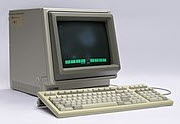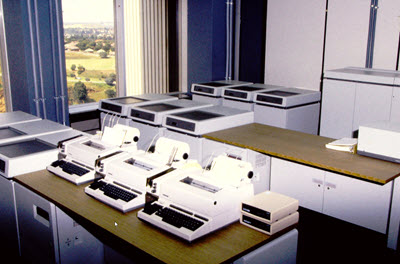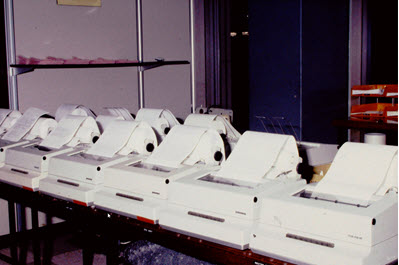Broadcast News Computer System
SABC
March 7, 1986

After visits to television news operations in England and the USA in 1984 by a SABC team consisting of Phil Bartel, Brian Horn, Rob Stevenson (TV News) and Tim Robson (Radio News), it was decided to award the contract in May 1985 to McKinnis Skinner in Kansas City. Several months later this company was acquired by Beston Electronics in Kansas City, which filed for bancrupty several months later, resulting in the SABC cancelling their contract.
This press release issued by the SABC in March 1986 came after the decision was made to develop the system inhouse following the failure of the initial contract.
The split screen software was developed using HP150 computers as terminals, HP giving the SABC access to the computer operating system software enabling the development. It should be noted that the first version of Microsoft Windows was released in November 1985, long after this project that been started.
The value of the contract which was just for computer hardware would be R42 million today, or $2.68 million.

The SABC's newsroom is taking a R3,5-million technology leap from being a typewriter and paper-driven department to become a totally computerised and paperless operation. The development will see the corporation operate one of the largest computerised news management systems in the media world today. And the experience gained in implementing what is considered to be the most innovative use of computers in news compilation and broadcasting could see the SABC recoup its investment with overseas sales to other broadcasting companies.
Hewlett-Packard computer systems, incorporating the latest in networking technology, will link broadcast editors, announcers, writers and wire services to mainframes and personal computers throughout the country. The HP hardware includes two new HP 3000s, a Model 68 and Model 58, an initial order of 90 HP 150 Model Ils with a projected total requirement of about 180 machines, an HP 320, and associated peripheral equipment. These are in addition to the SABC's Computer Service Division's existing HP installation of HP 3000 Model 58 and Model 42.
Software for the system is being developed by the SABC itself - a four-man-year project currently being carried out by a six-man programming team at the SABC. One of their biggest challenges is to develop a
split screen facility on the personal computers to enable the editors and writers, who will be using them, to translate easily from inputed text to any of the 13 languages in which the SABC broadcasts.
"Translating the news from one language to another has always heen a problem. The split screen and the HP equipment's ability to accomodate the extra nine special characters used in the different languages
will be a great aid to writers and broadcasters," said Brian Horn, SABC's Chief Engineer: Computer Services. Writers will also be able to use the split screen facility to call up agency supplied news stories
or research material on one half of the screen for editing and incorporation into main stories on the other half.
Core to the whole system is the HP 3000 Model 68C which will manage the entire raw news copy input, its assignment to writers, its subsequent scheduling in news broadcasts and finally its archiving in a library data bank.

Horn explained some of the other challenges which his team faces in developing the system. "To begin with we broadcast over 300 news bulletins a day on more than 20 services as well as provide a news wire service to neighbouring countries. Our broadcasts alone represent more than 25 hours of news output in a 24 hour period. "Add to this the input from all our reporters and the numerous foreign news agency wire services we use and you can imagine the volumes of paper we move around every day. "When the system is fully operational such paper overload will be a thing of the past. Even for the newsreaders, gone will be the days when bits of late-breaking news will be shoved in front of them. One of the later phases of the project will be to link the whole system into a computer controlled teleprompter," he said.
Another key area, on which his team has had to concentrate, is the archiving of all the news material. The system currently under development will enable writers and researchers to access information in the database library by simply entering key words associated with the subject under review. The database will then automatically present a complete index of the information stored on that subject for further selection. "This will facilitate the categorising and retrieval of news items," said Horn. "Searching by the use of key words means that items which might have been categorised under different titles will not now be overlooked."
Because of the critical nature of broadcasting, the maximum downtime allowed on the system is three minutes. To meet this specification, the new Model 58 being installed will act as a backup machine. It will run HP's new database automatic duplicating software called Silhouette, which mirrors all transactions in the primary database so that, in the event of a hardware or software failure, the user is automatically switched to the backup machine without any data loss.
HP's recently introduced Model 320 system is being installed to manage the massive input from overseas wire agencies. Copy to be used will then be uploaded into the main system as required. The other mini computers are used for the SABC's electronic mail and telex facilities as well as internally for such applications as project development and technical management. All these systems are linked to a new HP Local Area Network called Network Services 3000 for which the SABC is a world Beta test site. Data will be transferred between equipment at speeds of 10 Mbs compared with normal machine to machine rates of 9600 bps.

Together with the SABC's national data network which was established in 1984, users can now access information, transfer stories and schedule copy from any of the SABC's offices in the country. "This is going to become a very useful facility now that the SABC has become more regionalised with the establishment of local radio stations such as Jacaranda and Oranje," said Horn. "It will mean that the regions will have more control over their news output. Previously copy would be telexed to them complete. Now they can access all the raw copy, research archived material and localise the story if they need to, to suit regional requirements."
Apart from the pioneering work being undertaken in developing the news system, the SABC is also making major advances in the use of the Unix operating system. "The majority of our programming is being carried out in Pascal because of the language features and this is assisted by a readily available source of Pascal-trained graduates from the universities" said Horn. " Unix is being used for its multitasking capabilities and its transportability. "One of the reasons we opted for HP systems was because of the equipment's upwards compatibility. It means that versions of the system we are developing can run on HP's smaller Model 37s right up to the top end of the range. "This could be important in the future if we should ever market the system overseas. The SABC is a very large organisation competed with overseas broadcasting stations which tend to be smaller and independently run concerns so the ability of the project to run on both small and large systems was a very important consideration."
The SABC visited numerous stations throughout the world evaluating existing systems before opting for an HP-based development. The only comparable system was at the BBC in the UK. "There the system, used by the breakfast special news team, was running on a small HP computer incorporating 45 peripherals. We will have 240 peripherals when our system is operational, but the flexibility of the equipment, the Silhouette database software and the LAN, means that you can implement it whatever the size of the operation," said Horn.
"There's only one logistics problem we've discovered with our development so far," he added. "Because editors will be using their PCs in an intelligent local processing environment rather drawing off the main system as terminals, we will have to maintain 180 application discs. This means we really have to get everything bug free before we go live or we'll be spending all our time in the future updating discs." To ensure this does not happen Horn's department has worked closely with the newsroom staff throughout the development. Extensive training is now being implemented and practical testing carried out among news staff ready for full implementation by mid-year.